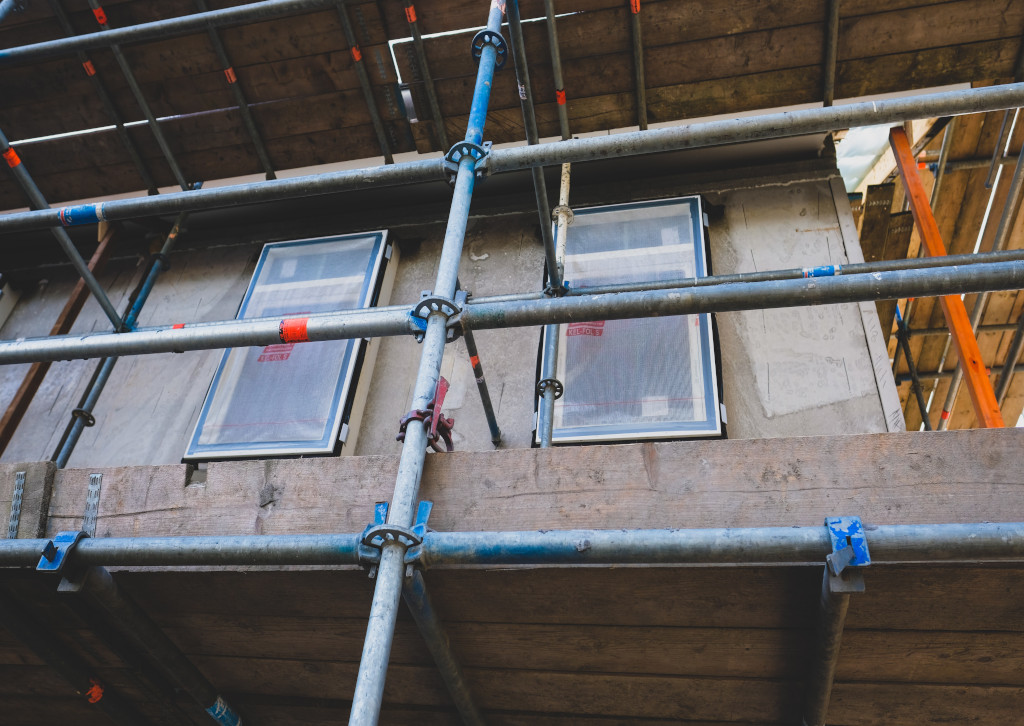Home » Construction Services (Page 9)
Category Archives: Construction Services
Akela Group moves into England with new Leeds hub
Scottish civils contractor Akela Group is moving into the English market with the opening of a new division in Leeds.
The new North of England hub will lead expansion plans outside of Akela’s traditional Scottish base.
The firm expects its business to grow by 10% over the next two years as a result of the move.

The new Leeds team will be led by Construction Manager, Martin Leahy, who brings over 15 years industry experience having previously worked with the Robertson Group and Laing O’Rourke.
Group company Akela Ground Engineering has secured its first contract at Knaresborough in the North of Yorkshire and is currently tendering for a variety of new housing and commercial build contracts throughout the county.
Across Scotland the Akela Group currently employs 300 staff providing civil engineering, construction, piling and training services.

Mark Markey, Akela Group Managing Director, said: “We are delighted to see our long term ambition to expand and grow the company in front of a UK audience come to fruition. We are seeing increased levels of demand for the wide range of ground engineering and civil engineering services, particularly in the North of England and we are well placed to meet that growing demand.
“The opening of the Leeds hub presents an excellent growth opportunity for the Akela Group and it will bring an abundance of employment opportunities and economic benefits to the region and beyond.”
Leahy said: “It’s an exciting time for the Akela Group and there is a huge opportunity to grow the business in the North and I am delighted to be leading the team at the new Leeds hub.
“I am passionate about collaboration and delivering insightful solutions for clients and l look forward to working on a wide range of projects as we realise the growth ambitions in the North of England.”


New Report Reveals Data Strategy is a Key Advantage in Construction
Discover key findings in infographic below
Advances in construction technology continue to accelerate what’s possible for the industry at large. The challenge with all this new technology is the sheer volume of project data it generates.
In fact, over the past three years alone, our research shows that new project data has doubled industry-wide. Couple that with common industry challenges in capturing, managing, and analyzing data, and we find a startling $1.8 trillion in cost impacts to the construction industry globally due to “bad” data. This is notably associated with the impact of bad data on decision-making.
This is where a clear data strategy can change everything.
In today’s construction landscape, working fast is a competitive advantage. Whether you’re coordinating with stakeholders, generating designs, or managing a jobsite, the speed at which you make decisions can make or break your projects.
With the right data management systems and strategies, construction teams can easily get the information they need to make good decisions that move projects forward at minimum risk.
A new report from Autodesk and FMI, Harnessing the Data Advantage in Construction, reveals the fundamental need for proper data management in construction, and the surprising cost of inaction. It also identifies current roadblocks and practical, actionable steps to implementing a data strategy that can make your projects significantly more profitable.
DOWNLOAD THE REPORT
Read on to get a glimpse of some key findings you’ll pick up from the report.

Key report findings and how they impact data strategy
Finding #1: Too much of your data is likely unusable or bad
Data is only as good as it is useful. So when it comes to construction data, true value lies in quality, not quantity. Having a lot of information isn’t necessarily a good thing, and that’s especially true if you’re looking at bad project data — i.e., your data is inaccurate, incomplete, inconsistent, or untimely.
In our research, 30% of the survey’s respondents indicated that up to 50% of their organization’s data are considered bad.
Having poor project data comes with consequences. Without accurate information, you won’t be able to make the best decisions, which can ultimately hurt your projects. In our research, respondents indicated that bad data led to poor outcomes in a third of their organization’s decisions.
As for the causes behind bad project data, our research found that the top contributors include:
- Inaccurate/Incorrect data (24%)*
- Missing data (24%)*
- Wrong data (21%)*
So, what should construction professionals do to address the issue of bad project data? One important step is to tighten up your data entry practices. Inconsistent data entry is the largest cause of bad data. So by standardizing how you capture information, you can prevent bad data from permeating throughout your organization, and negatively impacting your bottom line.
*Please refer to the full report for detailed definitions of bulleted items
Finding #2: Making field decisions using data is critical, but often undervalued
We’ve already established that having good data is essential to making sound decisions. However, this has serious impacts in the field because these are your frontline decision-makers. It’s your project management and field supervision staff that are collecting, managing, and analyzing data every week.
The biggest reason behind the lack of data-driven decision making, according to respondents, is the urgency required when making a decision. And when accurate data isn’t readily available, we’re forced to move forward even when we don’t have all the information. Here are the top three risks to project decision-making:
- Time constraint or urgency of decision (43%)
- Lack of reliable data (36%)
- Lack of experience with similar project decisions/issues (36%)
You can already see how good data serves to resolve major concerns associated with making critical decisions in the field. Read the full report to see the complete list of risks to decision-making.
Finding #3: Simply put, formally implement a data strategy
From the report, “The first step to supporting project staff who are tasked with data management and analysis is implementing a formal data strategy. Having a framework in place will lift the burden from busy supervisory staff and it will improve data consistency and insight moving forward.”
The problem for those without a strategy in place is that project data is not consistently informing decision-making. Only a fraction (12%) of respondents say that they always incorporate project data in their decision-making. Over 50% of survey respondents indicated they use project data when making decisions only occasionally, or even worse, not at all.
Our study found that respondents who “always” or “often” use project data when making decisions are more likely to have a data management plan or strategy already in place.
What elements should your data plan include? When asked about their own strategies, respondents highlighted they include the following components:
- Sources and collection methods
- Standards for project data formatting and processing
- Identifications and descriptions of data
- Methods and platforms for collecting, accessing, and sharing project data
- Archiving data
- Formal data management roles and responsibilities
The report also reveals what organizations put effort into when committed to quality data. Respondents said the following investments ensure decision-makers in the field can access actionable, high-quality data:
- Regularly reviewing data at set intervals for quality purposes (40%)
- Having established data reporting and monitoring practices, both at the time of collection and use (38%)
- Structuring data in a common data environment (38%)
Our findings clearly lead to the importance of implementing a formal data strategy for project data, but we found that only 55% of respondents have done so themselves.
Finding #4: Buy-in from your entire organization is vital
According to the report, “Even if organizations understand the benefits of having a data management strategy, the path to implementation may be littered with roadblocks. Clearly, project management and field supervisors should require a plan to collect, manage, and analyze data. However, without knowing what investment is required or where to begin, leadership may not back the project. Obtaining buy-in from all key stakeholders is necessary for the successful roll out of a data management strategy.”
When asked what is holding respondents back from implementing a formal project data plan/strategy themselves, the top three concerns included:
- Cost/required resources (40%)
- Not sure about where or how to start (36%)
- No leadership/organizational support (36%)
Further, organizations with revenue over $500 million were more likely to suggest “No leadership/organizational support” as a reason for not implementing a formal data strategy. This may be tied to how challenges manifest in a large construction firm compared to a smaller one, according to findings.
In the report, we also share key learnings associated with the lack of understanding benefits of a formal data strategy. There’s also the factor of workforce training. What do you do with all your data? Who manages it? How do you create consistency in entry, management and use of data?
We provide insight into those questions, and so much more, in Harnessing the Data Advantage in Construction, an in-depth report made in partnership between Autodesk and FMI. You can download it right now at no cost.
DOWNLOAD FULL REPORT
Download the report, Harnessing the Data Advantage in Construction, for actionable insights on the vital nature of a formal data strategy
At the end of the day, when equipped with good project data, construction stakeholders can rest easy knowing that they have reliable information at their fingertips to make important decisions quickly.
Accomplishing this requires having a formal data strategy in place, and one that’s executed by skilled team members. With these two components in place, you’ll be in an excellent position to leverage quality data for meaningful project decisions.
Download the report, Harnessing the Data Advantage in Construction: Why adopting a data strategy can bring firms a competitive edge.
If you’d prefer to listen and learn, you can download the audiobook version of the report as well.
The post New Report Reveals Data Strategy is a Key Advantage in Construction appeared first on Digital Builder.
Why Adopting a Data Strategy Gives Construction Businesses a Competitive Advantage – And Where to Start
Projects are built on thousands of decisions. The quality of every decision depends on data: having accurate, timely and complete information that you can use when you need it.
But right now, data management is an area where many European construction companies are struggling.
We might be generating more information than ever before. But whether that’s producing actionable insights – and better outcomes for the business – is another question.
We’ve surveyed 1,115 construction professionals and interviewed four contractors across Europe to understand their challenges in using data, as well as where they see the biggest opportunities for the future.
It’s clear that using data can seem overwhelming. So how can companies overcome their data management hurdles – and start making better decisions?
Read the full report, Harnessing the Data Advantage in Construction, from Autodesk and FMI.
Is more data always better?
Most construction professionals (82%) agree their organisations are collecting more data from construction technology today than three years ago.
There’s a clear resource implication, with 49% of project management and field supervision staff’s time spent collecting, managing and analysing project data each week.
However, 39% of professionals say that less than half of that data is usable. Worse still, 40% of the average organisation’s data is bad – meaning inaccurate, incomplete, inconsistent or untimely.
There seem to be challenges with the whole process, from knowing what data to collect (51%) to understanding how to manage project data effectively (52%), and firms are unsure how to fix the situation.
Bad data, bad decisions
Project managers have always been tasked with making decisions quickly. But with the Covid-19 pandemic disruption, there’s more pressure on schedules than ever before.
Professionals say that time constraints represent the single biggest risk to project decisions (38%).
Information is one of the best ways to manage risks, especially when decisions are needed at speed. But crucially, professionals often lack the data to make project decisions effectively. Only 9% always incorporate project data into their decision making – while 64% do this sometimes, rarely or never.
In fact, data that’s inaccurate, incomplete, inconsistent or untimely actually compromises decisions. On average, bad project data results in poor decisions 41% of the time.
Formal data strategies: the benefits and barriers
Many construction companies have measures in place to get more from their data – from a common data environment (37%) to creating a formal position to oversee their data (33%).
But European companies are divided when it comes to having a formal data strategy: a plan to collate insights from different projects and drive business-level improvements.
While 58% of organisations have a formal data plan in place, a third (33%) don’t. A further one in ten professionals (9%) don’t know either way – suggesting that if strategies do exist, they aren’t being well-communicated in the business.
Companies with a data strategy say the biggest benefits are fewer safety incidents, a reduction in change orders, fewer missed schedules and less rework.
But there are barriers to creating a data strategy. A lack of applicability (39%), cost and resources (37%) and not knowing where to start (35%) are the most common reasons for companies not to have a strategy in place.
Culture challenges
Success with data isn’t only about the digital tools; construction companies need the right company culture – and people who are comfortable and confident with technology.
Many businesses acknowledge the growing importance of digital skills; 36% of companies are providing formal training in data analysis, while 44% say data management and analysis skills will be important for project management staff to do their jobs effectively in the future.
However, there are signs that company culture could be a key hurdle. At 34% of companies, a lack of leadership and organisational support is the main reason there isn’t a formal data strategy.
Communication and leadership will be a crucial part of encouraging technology adoption, and making data strategies a success.
What’s next?
Using bad data can have far reaching consequences. A contractor performing €1 billion in work annually could avoid €7.1 million of waste could have been avoided by making decisions using accurate data, according to our research.
But every construction business can take incremental steps to improve their data management.
Start small and begin with data selection before data collection
Focus on the place where your organisation could most benefit from data-driven insights. Once you’ve refined your process and can show clear results, you can take lessons from this onto the next data management area.
Focus on buy-in to gain organisational support
Articulating why changes are happening, encouraging open discussion and providing continual reinforcement will help to achieve buy-in over time. Ensure that your team has ongoing support with using these new technologies and processes.
Poor data equals poor results, so put quality first
Define clear processes for capturing good data – and ensure that this is a foundation of your overall strategy. A common data environment and either a single technology platform or integrated technology platforms are needed to support the flow of data, and to form the basis for long-term data ambitions.
To find out more about creating a robust data strategy, read the full report: Harnessing the Data Advantage in Construction: Why adopting a data strategy can give firms in Europe a competitive edge.
The post Why Adopting a Data Strategy Gives Construction Businesses a Competitive Advantage – And Where to Start appeared first on Digital Builder.
Strike threat by cement drivers adds to materials woes
Lorry drivers employed by Hanson on the Castle Cement contract are holding a strike ballot in a dispute over pay.
The 200 plus lorry drivers and engineers, who are members of Unite, have rejected a pay offer of 2.5% for this year.
Unite added that “the workforce is deeply unhappy about the high handed management style and a marked lack of dignity at work.”

Drivers deliver dry cement to major sites and merchants across the country.
The ballot will open on Friday 10 September and close on Friday 23 September. If members vote for strike action industrial action could begin this October.
Unite national officer Adrian Jones said: “Our members are simply not going to accept a pay offer which amounts to a pay cut in real terms.

“With the ongoing driver shortage, our members are seeking a pay increase which recognises their hard work and dedication.
“If strikes do occur then it will have major implications for the construction industry. Supplies of cement will quickly run out, which will result in projects being delayed.”


Did you miss our previous article…
https://www.arizonasolarsociety.com/?p=492
Labour shortages could last for next two years
Business leaders are warning that labour supply problems could last for up to two years and will not be solved by the end of the furlough scheme.
CBI Director-General Tony Danker called on government to to get a grip on the situation as shortages hit construction and all other industries.
He said: “Labour shortages are biting right across the economy. While the CBI and other economists still predict growth returning to pre-pandemic levels later this year, furlough ending is not the panacea some people think will magically fill labour supply gaps.

“These shortages are already affecting business operations and will have a negative impact on the UK’s economic recovery.
“Other European countries are also experiencing staffing shortages as their economies bounce back. In the UK, many overseas workers left during the pandemic and new immigration rules make replacing those who left more complex.
“Building a more innovative economy – coupled with better training and education – can sustainably improve business performance, wages and living standards. But transformation on this scale requires planning and takes time.

“The Government’s ambition that the UK economy should become more high-skilled and productive is right. But implying that this can be achieved overnight is simply wrong. And a refusal to deploy temporary and targeted interventions to enable economic recovery is self-defeating.
“Using existing levers at the UK’s control – like placing drivers, welders, butchers and bricklayers on the Shortage Occupation List – could make a real difference.
“The Government promised an immigration system that would focus on the skills we need rather than unrestrained access to overseas labour. Yet here we have obvious and short-term skilled need but a system that can’t seem to respond.
“Great economies like great businesses can walk and chew gum. We need short-term fixes to spur recovery and long-term reforms to change our economic model.”


Did you miss our previous article…
https://www.arizonasolarsociety.com/?p=474
Builder breaks back in fall from work platform
A building contractor and roofing specialist have been fined after an employee fell five metres from a first-floor extension breaking several vertebrae in his lower back.
Liverpool Magistrates’ Court heard that on 11 June 2018, Grayton Building Contractors Ltd was undertaking a first-floor extension to a residential bungalow in Aughton.
An employee was fitting fascia boards and soffits to allow roofers employed by Thomas Dean, who had arrived on site a week early, to commence work.

While stepping across a gap in the incomplete working platform to descend from the roof, the ladder, which was not tied, slipped sideways, causing him to fall. As a result of his injuries he was unable to work for eight weeks.
An HSE investigation found that both Grayton Building Contractors Ltd and the roofing contractor Thomas Dean failed to properly plan the work, to assess the risks and to provide appropriate supervision. Subsequently the work at height equipment selected was not suitable and the work was not carried out safely.
Grayton Building Contractors Ltd of Southport pleaded guilty to safety breaches and was fined £15,000 and ordered to pay costs of £3,742,

Thomas Dean of Merseyside also pleaded guilty and was fined £400 and ordered to pay costs of £3,000.
Speaking after the hearing, HSE inspector Andy McGrory said: “The risks from working at height are well known. Those in control of the work have a responsibility to devise safe methods of working, which should include ensuring the use of suitable work equipment and adequate supervision.
“The incident could have easily been prevented with simple precautions including properly planning the work, undertaking a suitable risk assessment and by selecting, erecting and using suitable work at height equipment for the job.”


Did you miss our previous article…
https://www.arizonasolarsociety.com/?p=468
4 Tips For Obtaining Construction Surety Bonds

The ability to obtain surety bonding is a necessity in the commercial construction industry. Public entities typically require bid bonds along with performance and payment bonds for their projects.
![]()
Did you miss our previous article…
https://www.arizonasolarsociety.com/?p=459
Must-Have Construction Software Buyer’s Guide & Checklist
If you’re on the hunt for new construction management software, you’ve probably noticed that there are more options than ever. Research analysts predict that construction technology tools will continue to see steady growth until 2025. With the market being flooded with an overwhelming number of options, construction firms need to be strategic when it comes to picking software solutions that provide a return on investment. And “investment” is the key word to remember, rather than evaluating construction software as a one-time buy.
Fortunately, we’ve released a new construction software buyer’s guide to help you successfully evaluate and choose the right tools for your firm.
Download Ebook
Pair our buyer’s guide with this checklist to jump start the evaluation process and select the best construction software to fit your needs. Download the free checklist now to get started.
DOWNLOAD CHECKLIST
What are some must-haves when selecting construction software?
Cloud-based with Centralized Data
As a top priority, your construction software should be cloud-based. This is a key element of modern collaboration in construction. Firms that have adopted cloud-based construction software reap the benefits of streamlined workflows, greater productivity, and higher visibility into their projects.
What makes choosing a solution in the cloud so essential? Cloud-based software works from anywhere, reflecting the way people work today. Teams can work collaboratively in real time, or even offline when in remote locations. And as soon as you’re connected again, all your work will sync seamlessly to the project. Using cloud services isn’t only about data storage and digitizing workflows. It’s about embracing a new way of working—one where accessibility, automation, and collaboration come first.
Instead of manually moving documents to and from the cloud, your team will work together on improving existing processes and workflows, allowing for greater efficiency and less waste.
Made for Mobile
Construction teams are always on the go. Whether you’re in the field or in an office, you’ll probably still move between multiple locations throughout the day. You should be able to take your work with you and access it on the go. For teams in the field, it’s especially important to have mobile access to documents, as well as advanced functionality to collaborate in real time.
When searching for construction management software, make sure it’s natively mobile. That means the solution was purpose-built for mobile devices. If you pick a solution that isn’t built for mobile devices, you’ll find it is too difficult for teams to adopt and use. Tools that are built for desktop and then retrofitted to work for mobile don’t provide a seamless, intuitive user experience. Simply put, tools that are difficult to use are far less likely to be adopted by your team.
Easy-to-Use with Intuitive Interface
Make sure your construction software has an intuitive interface. It must be easy to use. Solutions that require extensive training for mastery only cause frustration, even for power users. Your teams will be relying on this software, often on the go, so accessing important information must be simple and fast. Look for construction software that makes it easy for your team to input data, provide updates, and exchange project-critical information.
Look for a Connected Cloud Environment
As your firm grows, your technology needs will evolve, and your construction management software needs to support that growth. To make scalability possible, avoid using disconnected point solutions that put critical data into silos. But we’re talking about more than just a cloud-based solution here. Rather, you want to look for a more comprehensive construction software solution that connects all your processes with a single environment. With so many workflows in construction relying on accurate, real-time data, when decision-making matters most, you want to respond quickly. However, it can take days, weeks or even months to clean, compile and analyze project-critical data. No one wants to halt a project because a decision can’t be made.
Your ideal cloud environment for construction will bring all of your key project data into a single source. Whichever tool you choose should leverage what is called a common data environment, or CDE. This serves as your foundation for more profitable projects because everyone—from design and planning to construction and handover—is looking at the same reliable data to make decisions. You’ll be able to review insights, analyze data, collaborate with stakeholders, and make accurate forecasts. The right solution for your firm not only works today, but far into the future.
Supports Robust Integrations
With the sheer volume of technology supporting the industry today, the truth is there’s no single solution that can “do it all”. Identifying a software partner that supports a robust integration ecosystem is important, but must also provide meaningful ways to share data across all your teams’ tools.
If data cannot be shared in a useful way, or made accessible in a practical format, your integrations are more likely to hold you back. On top of that, you’ll want integrations that are actively supported for years to come as the industry, and your own technology needs evolve.
Backed by Cutting-edge Technology
In the future of construction, we’ll continue to see predictive analytics, machine learning, and AI play a significant role. The best construction software solutions integrate these advancements into their technology ecosystem so you can quickly convert data into actionable insights.
Partnership with Your Software Solution Provider
You need more than ‘just a software solution’ to stay competitive and extract the most value out of your project data. Additionally, your software provider should serve as a partner who is invested in your long-term success. They’ll be there as a guide and educator, offering training and support whenever questions come up.
Download the Buyer’s Guide Today
These features are all essential in a construction management software solution. To learn more about evaluating construction software and round out your list of must-haves, download our buyer’s guide and checklist.
Download Buyer’s Guide
Download Checklist
The post Must-Have Construction Software Buyer’s Guide & Checklist appeared first on Digital Builder.
What Are As Built Drawings?
If a picture can speak a thousand words, in a project, as-built drawings can speak a thousand construction processes. But in all seriousness, with the hundreds and thousands of steps and documents needed to complete just one project, as-builts might be overlooked for their importance. Nonetheless, as-built drawings remain an essential process in a project, especially to maintain a project’s lifecycle after construction has ended.
Despite this, as-builts are often not included, or are only addressed right at the end when an accurate product is far less achievable because of a failure to record changes to the project along the way. Below, we provide a thorough look at what as-built drawings are, who creates them and why they’re important. We’ll also offer a roundup of the most critical items to include in each as-built drawing.
What Is an “As-Built?”
Also known as record drawings and red-line drawings, as-builts drawings are documents that allow a compare and contrast between the designed versus final specifications, and provide a detailed blueprint of the building and the land around it as actually constructed in the end. According to Business Dictionary, as-builts are a “revised set of drawings submitted by a contractor upon completion of a project or a particular job. They reflect all changes made in the specifications and working drawings during the construction process, and show the exact dimensions, geometry and location of all elements of the work completed under the contract.”
The final as-built drawings include any and all of the following, as well as every other change made during the construction phase of a project:
- Modifications
- Field changes
- Shop drawing changes
- Design changes
- Extra works
As-built drawings go hand-in-hand with as-built surveys, also called as-built maps. These are used during the construction phase to continually track how the land and building is changing as work progresses. Dedicated as-built surveys make as-built drawings much easier to construct in the end, because of the greater level of detail recorded from every stage of the project.
Who Creates As-Built Drawings?
Typically, the architects or designers who originally designed the project will also create the as-builts. They are familiar with the original specifications and are therefore the most qualified to reflect recorded changes. According to Cornell University Facilities Services, the people in charge of as-built drawings differ depending on whether the design job is in-house or from an external party, like the contractor:
“For in-house design jobs … these could be put together by anyone on the design team or the shops,” whereas for “out of house design jobs … the drawings are put together by the contractor, typically with the assistance of sub-contractors for submittal to the architect for inclusion in the record drawings.”
As mentioned, as-builts on a whole are much easier to accomplish with detailed notes from every phase of construction. Because truly useful as-builts require so many nitty gritty details, it’s simpler to use technology to record changes along the way than it is to try to recover the details of those changes afterward. One helpful tool to detail changes is mobile technology powered by construction software to enable you to track adjustments immediately, avoiding loss of changes and errors in recording them.
Why Are As-Builts Important?
While submitting as-built drawings is not necessarily a must on every job, it’s a helpful component to any completed project, and if completed correctly, reflects well on your company’s professional image. As the Construction Management Association of America explains:
“They are important for those who use the finished product, as they provide a legacy of what was actually built. This legacy becomes more important, as we continue to build on top of old work, land ownership changes or for public works, as employees familiar with what was-built are replaced over time by attrition.”
As-builts, in other words, ensure that as designers, architects and contracts move on from the project and, a resource still exists beyond the original blueprints.
Overall, as-builts are important for four main reasons:
- Improves onboarding: As subcontractors are added to a project, delivering a set of as-builts helps teams get access to the right information quickly, which allows getting up to speed starting work sooner.
- Assists the facilities team: With a full record of change, facility teams can meet issues faster and owners can save money down the road due to improved operations and speed
- Streamlines permitting process: Oftentimes, government agencies request sets of as-builts in order to issue building permits.
- Improves the renovation process: With a full history of project changes, owners can see exactly what has been built and do not have to invest heavily in learning about existing conditions
Why Should Contractors Care?
If you’re a general contractor, you might be thinking, “why should I prioritize as-builts at the end of a project?” The truth is, you shouldn’t just focus on creating as-builts; you should strive to elevate the quality of the packages you provide, too.
Good as-builts drawings can do wonders to improve your reputation as a company and increase your business in the long-term. If you’re a subcontractor, as-builts can be especially important as you might be hired for system maintenance and renovations. At this point, the information and data found in packages won’t just benefit owners, it will benefit your ability to successfully complete a job.
Looking to learn more about how to create quality as-built drawings? Read on.
What Should Be Included in As-Builts?
In order to make your as-builts as clear and useful as possible, you must include a wide variety of details and documents. This information includes, but is not limited to:
- Recording changes in scale, or ideally using the same scale as the original drawings
- Using clear labels and descriptions rather than vague phrases such as “similar” or “equal to”
- Including changes in sizing, materials, dimensions, location, installation, fabrication and so on
- Noting unexpected obstructions encountered, and the solutions decided upon
- Noting dates when changes were made
- Recording any changes made as a result of final inspection
- Attaching all related shop drawings and appendices
Obviously, this is a significant amount of information to include and needs a great deal of detail to be recorded along the way. Although this can seem like a daunting and time-consuming prospect, it’s presumably less intimidating than telling a client no as-builts are available, or turning in shoddy work that does not serve them (or your chances of getting rehired) in the long run. Nonetheless, mobile technology can assist in putting this record process in practically auto-drive.
Where As-Builts Fall Short Today
If the goal is to improve as-builts, then we must pinpoint where they’re falling short today. Otherwise, it’s impossible to address the real problem where it lies. So what’s the issue? In the long run, it comes down to inadequate documentation. As we saw in the case of Burlington mall, missing information is a common reason why projects get delayed or halted.
Too many as-builts exhibit missing information and errors, at least partially due to a lack of commitment on the construction team’s part. Today’s as-builts:
- Often lack the right kind of documentation
- Fail to back up statements with photographic evidence or drawings
- Don’t capture data at a deep enough level
- Don’t effectively provide for later updates and additional documentation
- Frequently are disorganized, making it nearly impossible to sort through the information
Again, a lot of this is due to missing motivation and commitment. To capture the needed and accurate information that quality as-builts rely on, teams must go into a project intending to do just that.

6 Solid Strategies to Improve As-Builts
So now that you understand why they’re important and where they frequently fall short today, it’s time to kick your as-builts game up a notch. Here are six next-level strategies to help you do just that.
1. Set As-Builts Up for Success Before Construction Begins
As we mentioned, a reason why teams fail to create detailed and accurate as-builts is that no system was set up for success in the first place. The worst thing teams can do is to try to create a complete set of as-builts drawings at the end of construction. Instead, before construction begins, there needs to be a place where data can be captured, stored, edited and distributed throughout the process. If there isn’t, then we can’t blame teams for failing to do so.
Luckily, there’s a solution: To improve as-builts and boost productivity, nothing can beat the cloud to store project plans and updates. With easy digital access to as-builts from anywhere, you can ensure all changes are captured and recorded. That means teams can add the necessary documentation out in the field, from phones and tablets, rather than waiting until they get back to the office and trying to remember all the crucial details or transcribe them from field notes.
With cloud access from the start of a project, snapping photos, jotting notes and uploading everything on the spot becomes a cinch and creates more accurate as-builts as a result.
2. Make High-Quality As-Builts Part of the Project Culture
There’s no way to improve as-builts if management is not on board. That’s why it’s so important to create a culture behind data capture, which will ensure not only that you maintain as-builts as you go along but that they are of the highest possible quality. This is easier said than done, and it starts with educating teams on why as-builts matter, training them on how to create them and setting expectations that they will be completed to certain standards.
Teams should know why and how to input the data into the primary document system. There should be specific workflows and protocols set up by a project administrator also to standardize this.
3. Go Deep With Data
Quality of data matters in as-built drawings–and the more, the better. There are tools and technology to increase the capture of data to help O&M and future construction teams and to improve as-builts, you must make use of them. To create better as-built drawings, it helps to utilize technology that gets you a high level of project data from the start. Three of the best technologies today include:
- Laser Scanning: This is a tool that’s particularly useful for site surveying, measuring measures millions of points within a 360-degree space. This survey tool makes it possible to quickly and accurately measure the distance between two points, saving loads of time in the planning and prepping stages. The data can be used throughout the construction process to collect data for as-built drawings.
- Building Information Modeling: BIM data–captured from both design and construction–is essential to include in the as-built, which are called “as-built models” in BIM. High-quality information can be used, as well as updated, for teams to visualize components and products in a facility when they have to make repairs or conduct maintenance.
- Connected Construction Data: Have you ever lost critical project data? Poor interoperability of systems and lost data adds up – equating to nearly $11 billion annually for owners. To build high-quality as-builts, teams cannot afford to have any data slip through the cracks. Connected construction software platforms help to ensure data is retained. For instance, Autodesk Construction Cloud
 enables all building information –assets, documents, models, and more – be gathered, organized, and turned over to the owner, so they are “ready on day one” to operate the building. With all the information at their fingertips, facilities managers have a comprehensive digital record set in one easy-to-access place to manage all building maintenance and operational needs efficiently. Even when it’s time for future renovations or rebuilds, the connected construction technology provides all the information owners need to make cost-effective and data-driven.
enables all building information –assets, documents, models, and more – be gathered, organized, and turned over to the owner, so they are “ready on day one” to operate the building. With all the information at their fingertips, facilities managers have a comprehensive digital record set in one easy-to-access place to manage all building maintenance and operational needs efficiently. Even when it’s time for future renovations or rebuilds, the connected construction technology provides all the information owners need to make cost-effective and data-driven.
4. Include Photos
A picture is worth a thousand words, and if we kept that in mind, we could increase the detail and effectiveness of as-builts immediately.
While construction relies heavily on drawings, and they’re not going anywhere anytime soon, they can’t always capture everything that a photo can. To paint an accurate picture of what a project’s existing facilities contain, there’s nothing better than construction photos.
Even better: When photos contain GPS data, they also provide an additional and extremely valuable level of detail to as-built drawings. Facilities teams can use this data to see exactly where the location of a photo is to a drawing–especially important when teams are looking at complicated systems behind walls, or in otherwise hard-to-get locations.
5. Create “Living” As-Builts
If we want to improve as-builts, we need to wrap our heads around the fact that, much like a living organism, a building changes from day to day. Renovations and changes are made all the time. Even small adjustments matter to a building’s future makeup.
Therefore, a project’s as-built drawings shouldn’t remain static; there needs to be an avenue to update and adapt them from the start. That requires that as-builts:
- Be available to anyone who needs them, from future construction teams to O&M staff
- Be accessible from anywhere, which means they need to be in the cloud
- Permit stakeholders to update and provide future documentation
- Allow linking between documents so you can easily connect a sheet to the RFI it references
With these factors in mind, it’s possible to preserve the quality and integrity of the building over its lifespan through as-builts.
6. Keep in Mind that Presentation Matters
Appearances matter. We instinctively know this, which is why we wear nice clothing to interviews and put sprigs of parsley on platters of fish. Yet too few construction teams bring this innate human emphasis on presentation to as-builts, and that has to change.
For contractors, exporting a disorganized turnover package with as-built drawings not ordered reflects poorly on them. To be useful, as-builts should be organized and searchable, across time, trade and file formats. This can be achieved with the right construction software platform.
Construction software, such as Autodesk Build, can help teams assemble and export organized as-builts that owners and facility teams can easily access and utilize. Not only does this simplify O&M efforts later and add value to a project, but it can also help contractors themselves do better business if they’re hired for a renovation or addition project down the road.
Use Technology to Produce Better As-Builts
If you’d like to create the highest quality as-builts, then utilizing mobile technology is your best option. The right construction technology will enable you to record all field changes in real time, helping you to quickly review and apply that information to your resulting as-built. Taking that need a step further, we created the As Built Export tool for Autodesk Build—allowing your handover process to go much smoother.
One major thing to keep in mind when choosing construction technology to assist with the creation of as-builts is to choose a technology solution that prioritizes data portability. Data portability means that all the data generated from the construction process is available both physically and digitally to the facility maintenance team who will be accessing it. In short, this accurately helps ensure that this is one source of truth.
So, don’t spend any more time fearing as-builts—with the right knowledge and tools, you can successfully (and painlessly) capture an accurate snapshot of your entire construction project.

The post What Are As Built Drawings? appeared first on Digital Builder.
Did you miss our previous article…
https://www.arizonasolarsociety.com/?p=425
London secures £3.46bn affordable homes grant – list
The London Mayor has secured £3.46bn to deliver 29,456 homes with councils and housing associations from the first round of bidding for the next five-year affordable homes programme.
These fresh grants cement the council housing comeback in London, with more than four in 10 of the homes being built by councils, totalling 12,024 homes.
More than half of the social rented homes will be built by councils, and 57% of all homes will be for social rent.
A further £5.2bn was announced by the Government today for affordable homes to be delivered outside London by Homes England, but details have yet to be released.
The Mayor’s new 2021-26 programme – running alongside the extended 2016-23 programme – will see 79,000 new homes started over the next five years.
In total, almost six in ten of the homes (16,739 homes) funded by the first round of this affordable homes programme will be made available at the cheapest social rent.
The remainder will be for shared ownership and London Living Rent which can help Londoners on average incomes move into homeownership.
The Mayor has set ambitious targets for London to be a zero-carbon city by 2030 and expects homes built with funding announced today to be environmentally sustainable.
New standards introduced in the Mayor’s New London Plan include requirements for all developments of ten or more homes to be net zero-carbon and to incorporate sustainable urban green spaces.
Housing providers building homes funded by the new AHP will also have to meet new conditions on building safety and design.
AHP funding project conditions
1. The installation of sprinklers or other fire suppression systems in new blocks of flats
2. A ban on combustible materials being used in external walls for all residential development, regardless of height
3. Minimum floor-to-ceiling heights and a requirement for private outdoor space
4. A ‘sunlight clause’ requiring all homes with three or more bedrooms to be dual aspect, any single aspect one- or two-bedroom homes to not be north-facing and at least one room to have direct sunlight for at least part of the day
The Mayor of London, Sadiq Khan said: “I am delighted that we have been able to come to a deal with the Government to get started on nearly 30,000 genuinely affordable homes.
“Today’s funding is good news but I know we can still go further, faster, working with ministers, housing associations and councils to deliver more of the homes Londoners so desperately need.”
Did you miss our previous article…
https://www.arizonasolarsociety.com/?p=424